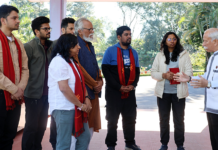NEW DELHI, 21 May: Up to 50 percent of the world’s rangelands – vast open areas suitable for grazing livestock – are estimated to be degraded, posing a severe threat to food supply and survival of billions of people, the UN warned in a new report on Tuesday.
Launched in Ulaanbaatar in Mongolia, the UN Convention to Combat Desertification’s (UNCCD) ‘global land outlook thematic report’ attributed the degradation of the immense natural pastures and other rangelands to overuse, misuse, and climate change.
The degradation is driven largely by conversion of pastures to cropland and other land use changes due to population growth and urban expansion, rapidly rising food and fuel demands, excessive grazing, abandonment (end of maintenance by pastoralists), and policies that incentivise overexploitation.
“When we cut down a forest, when we see a 100-year-old tree fall, it rightly evokes an emotional response in many of us. The conversion of ancient rangelands, on the other hand, happens in silence and generates little public reaction,” said UNCCD Executive Secretary Ibrahim Thiaw.
“Sadly, these expansive landscapes and the pastoralists and livestock breeders who depend on them, are usually underappreciated,” Thiaw said.
Pastoralist communities are frequently overlooked, lack a voice in policymaking that directly affects their livelihoods, are marginalised, and are even often seen as outsiders in their own lands, he added.
Covering 54 percent of all land, the rangelands include savannas, shrublands, wetlands, tundra and deserts. Altogether, these lands account for one sixth of global food production and represent nearly one-third of the planet’s carbon reservoir.
Two billion people – small-scale herders, ranchers and farmers, often poor and marginalised – depend on healthy rangelands worldwide.
In many West African countries, livestock production employs 80 percent of the population. In Central Asia and Mongolia 60 percent of the land area is used as grazing rangelands, with livestock herding supporting nearly one-third of the region’s population, the UNCCD said.
Ironically, the report underlined that efforts to increase food security and productivity by converting rangelands to crop production in mostly arid regions have resulted in degraded land and lowered agricultural yields.
It called out “weak and ineffective governance,” “poorly implemented policies and regulations,” and “the lack of investment in rangeland communities and sustainable production models” for undermining rangelands.
Rangelands occupy about 121 million hectares in India and a large part (around 100 million hectares) of these is considered underutilised. This includes degraded forest lands, land unsuitable for crop production, ravines, and wastelands.
The report highlighted that around 120 million hectares of land in India are degraded due to water erosion (82 million hectares), wind erosion (12 million hectares), chemical contamination (25 million hectares), and physical degradation (1 million hectares).
Crop losses due to water erosion in India alone are estimated to be USD 3.5 billion.
Committed to achieving its targets on land degradation neutrality (LDN) and ecosystem restoration, Indian has launched or reinvigorated several LDN-related programmes, including the National Afforestation Programme, Green India Mission, and the Watershed Development Component.
Together, these programmes are expected to help restore 26 million hectares. “Although grasslands are considered threatened ecosystems in India, they have been virtually overlooked in environmental conservation and ecosystem restoration policies in favour of forestry-based interventions, which includes converting natural grasslands into plantation forests or other uses,” the UN report said.
Less than 5 percent of India’s grasslands fall within protected areas, and the total grassland area declined from 18 to 12 million hectares between 2005 and 2015, it said.
Fortunately, there is a gradual shift towards recognition of the social-ecological role of rangelands and pastoralism, and India has recently taken a more encouraging approach, the report’s authors noted. (PTI)




